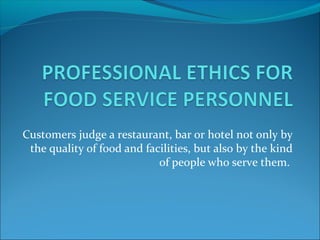
Professional ethics for food service personnel
- 1. Customers judge a restaurant, bar or hotel not only by the quality of food and facilities, but also by the kind of people who serve them.
- 2. Professionalism is a quality that is projected in terms of: 3 KEY ELEMENTS OF PROFESSIONALISM 1. Physical Projection - Appearance, poise, posture and body language 2. Verbal Projection - quality of speech , diplomacy and tact in words and expressions used, including the tone, volume, non-verbals. 3. Conduct and behavior -practice of basic courtesies, tolerance for difficult guests and costumers, compliance to service standard.
- 3. A. Physical Projection 1.It is advisable to require employees to wear uniform. But it must be properly pressed, no sagging hemline, not faded etc. -if not in uniform, they should refrain from wearing too casual attire like step-in, maong, T-shirt without colar., etc. 2. Avoid too many jewelries, dangling earrings, low neckline or too much make up 3. Always carry a pleasant smile and positive disposition so that others will feel more comfortable and at ease with you. 4. Be careful of overtone- tone, volume and body language. Avoid unpleasant non-verbal like sneering look, crrosing arms, pointing finger, frowning face, deep signs, biting lips, shaking head, etc. Keep a low modulated tone and volume. 5. Maintain poise and posture by direct eye contact, erect posture, refraining from unpleasant mannerism like scratching head, etc.
- 4. Strictly observe the following grooming standards:Hair - Clean and neatly combed, no dandruff. - Ladies hair should be clipped on both sides or breaded (if it is long) - Length of men’s hair should no go beyond collar and the side hair must not cover ears. - Bangs should be avoided. Uniform - Must be comfortably fit; no sagging hemline - Properly buttoned; sleeves should never be folded nor rolled. -clean and well pressed; free from stains nor wrinkles
- 5. Face - Men- free of beard and moustache - Ladies- must have light and appropriate make-up that should be retouched from time to time. - Free from pimples and blemishes. Mouth -free from bad breath; mouth wash to be used as needed - no tooth decay Ears -Clean and free from visible dirt inside and outside -Earrings are never appropriate fro men; ladies in uniform should never wear dangling earrings
- 6. Body -Free from body odor; deodorant to be used daily -Daily shower is a “must” Fingernails -Clean and free from dirt -Men- nails should be short and properly trimmed. -Ladies- avoid very long fingernails and must always be clean and well manicured. If cutex is used, it should look clean, fresh and not tattered. Perfumes -Not allowed much as the smell contaminate the food. Excessive Jewelries -not appropriate.
- 7. B. VERBAL PROJECTION Speak with clarity. Check if you are understood after sending a message. Speak in audible, relaxed and natural manner, maintain conversational tone and volume. Observe right speed, not too fast or too slow. When receiving messages, always seek to confirm or clarify anything that sounds unclear. “if I got you right, are you saying that… “I heard you say… do you mean….? Accept and respect the opinion and ideas of others. If you disagree, acknowledge first their statement before pointing out your ideas. Make statement like: “I see your point” I understand what you mean. However, I feel that..”
- 8. Make It a habit to use magic words like: May I, kindly, Please, Do you mind, I’m sorry, etc. “May I have your name sir? Instead of what is your name? “May I know who is on the line?, rather than who is this? “What can I do for you ma’am/sir?, rather than ask “What is it?” or What do you want from____” Avoid saying directly no or no comment be when turning down a request. One diplomatic way of doing it is to say: “I really wish I could satisfy your request, however……. I hope you understand.” Be sensitive to the feelings and self esteem of others. Avoid words or expressions that hurt feelings and shatter other’s self esteem. Listen with interest and undivided attention. Nod if you agree , ask questions. Paraphrase statements to confirm. Be honest and accurate in giving information do not bluff. Admit if you don’t know the answer.
- 9. WORK BEHAVIOR AND HABITS Some habits to be avoided while on duty are: 1. Unsanitary practices like: smoking, coughing/sneezing, scratching body parts, spitting on walls and floors and sink, tasting food in view of costumers, handling food with bare hands, serving food/cutleries that have fallen on the floor, putting on foods in dirty tables, cooling warm/ hot food by blowing air out of the mouth, wiping perspiration with wiping cloth used for service, combing hair inside dining room, using strong perfume. 2.Unpleasant Habits like: Yawning, grouping together with other staff for a chat while on duty, Using sign language, etc.
- 10. WORK BEHAVIOR AND HABITS Some habits to be avoided while on duty are: 1. Unsanitary practices like: smoking, coughing/sneezing, scratching body parts, spitting on walls and floors and sink, tasting food in view of costumers, handling food with bare hands, serving food/cutleries that have fallen on the floor, putting on foods in dirty tables, cooling warm/ hot food by blowing air out of the mouth, wiping perspiration with wiping cloth used for service, combing hair inside dining room, using strong perfume. 2.Unpleasant Habits like: Yawning, grouping together with other staff for a chat while on duty, Using sign language, etc.